Are you curious about the state of blogging in 2022? Then look no further.
We’ve curated, vetted, and categorized a list of up-to-date statistics below.
Click to jump to a category, or keep reading for our top blogging statistics:
These are the most interesting blogging statistics we think you should know.
- Long-form content gets an average of 77.2% more links than short articles (Backlinko).
- 60% of marketers report that content marketing generates demand/leads (Content Marketing Institute).
- 74% of companies indicate that content marketing is increasing their marketing teams’ lead quality and quantity (Curata).
- There are more than 600 million blogs out of 1.9 billion websites in the world (Hosting Tribunal).
- The number of bloggers in the U.S. is estimated at 31.7 million in 2020 (Statista).
- 77% of internet users read blogs (Social Media Today).
- There is a strong positive correlation between word count and backlinks, but only up to 1,000 words. For posts longer than 1,000 words, there is a strong negative correlation between word count and backlinks (Ahrefs).
- There is a moderate positive correlation between content length and organic traffic, but only up to 2,000 words. For posts longer than 2,000 words, there is a moderate negative correlation between word count and organic traffic (Ahrefs).
- 77% of bloggers report that blogging drives results (Orbit Media).
- Bloggers who publish more often are more likely to report “strong results” (Orbit Media).
- Bloggers who include 10+ images per post are the most likely to report “strong results” (Orbit Media).
- 65% of B2B buyers cite vendor websites as one of their most highly influential content types. This is followed by third-party websites (48%) and third-party articles by independent publishers (39%) (MarketingCharts).
- According to an article by Chicago Tribune, 59% of links shared on social media are shared without ever being read. But Twitter’s new prompt to get users to read before sharing has led people to open articles 40% more often (Vox).
- 73% of marketers report successfully using content marketing to nurture their leads, while 64% of marketers report successfully using content marketing to generate sales and revenue (Content Marketing Institute).
What’s the state of blogging in 2022? Here are some statistics that may surprise you.
- Internet users in the U.S. spend 3X more time on blogs than they do on email (Social Media Today).
- Tumblr hosts over 518 million blogs, while WordPress hosts over 60 million blogs (Hosting Tribunal).
- WordPress powers over 42.8% of the internet (W3 Tech).
- Roughly 70 million new posts are published on WordPress each month (WordPress).
- On average, 77 million new comments are added to WordPress posts per month (WordPress).
- From 2021 to 2025, the global content marketing industry is expected to grow by $417.85 billion (ReportLinker).
- 44% of buyers say they typically consume three to five pieces of content before engaging with a vendor (Demand Gen Report).
- More than half of consumers will stop what they are doing if they encounter issues when viewing content (Adobe).
- 89% of marketers used blogs in their content strategy in 2020 (Content Marketing Institute).
Do bloggers really earn money? Or is it just a pipe dream? Check out these statistics on blogging revenue.
- 33% of bloggers don’t earn any money at all (TechJury).
- The most popular monetization method for bloggers is Google AdSense, followed by affiliate marketing. However, for high-income bloggers, AdSense ranks third; bloggers are 2.5 times more likely to sell their own product or service than use AdSense (GrowthBadger).
- Bloggers make the vast majority of their income from ads, affiliate products, sponsored product reviews, their own products, and online courses (RankIQ).
- 45% of bloggers who earn over $50,000 per year sell their own product or service, while only 8% of lower-income bloggers do that (GrowthBadger).
- 72% of bloggers making $2,000+/month use either Mediavine or Adthrive as their ad management company (RankIQ).
- Blogs are responsible for around 40% of all publisher commissions in the U.S. (Awin).
- The most profitable niche is the food blog niche. Food bloggers have the highest median monthly income ($9,169) as compared to bloggers from all major niches (RankIQ).
- The niches that have the highest percentage of blogs with over 50,000 monthly sessions are food (42.8%), lifestyle (13.3%), and travel (10%) (RankIQ).
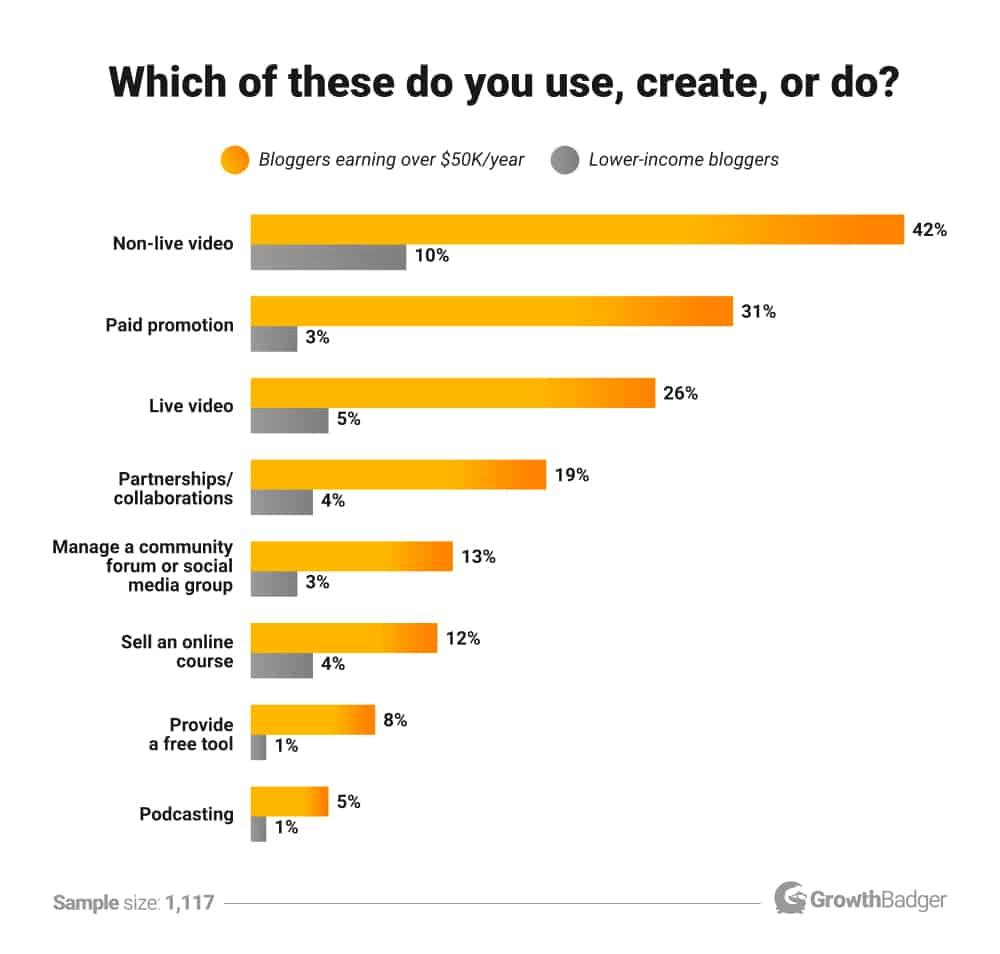
How long should your blog posts be? How often should you publish? When should you publish? These are questions bloggers always want to know.
- Engagement starts to drop for posts with a reading time longer than seven minutes (Medium).
- 73% of people admit to skimming blog posts, while 27% consume posts thoroughly (HubSpot).
- 75% of the public prefers reading articles under 1,000 words (Contently).
- The average blog post takes just over four hours to write (Orbit Media).
- The average blog post is 1,416 words (Orbit Media).
- About 50% of bloggers publish weekly or “several posts per month” (Orbit Media).
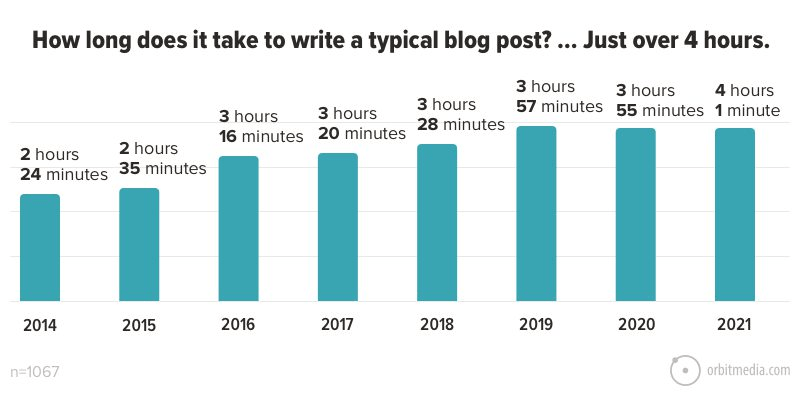
As competition intensifies, bloggers need to create higher-quality content. Check out these statistics on content formats and quality.
- “Quality of content” is rated the #1 most important success factor among all bloggers. However, higher-income bloggers put much more emphasis on promoting their content than lower-income bloggers do (GrowthBadger).
- The majority of bloggers add around two to three images per blog post (Orbit Media).
- 41% of bloggers are conducting and publishing original research (Orbit Media).
- Only 26% of bloggers work with editors (Orbit Media).
- The most common complaints about content—too wordy, poorly written, or poorly designed (Adobe).
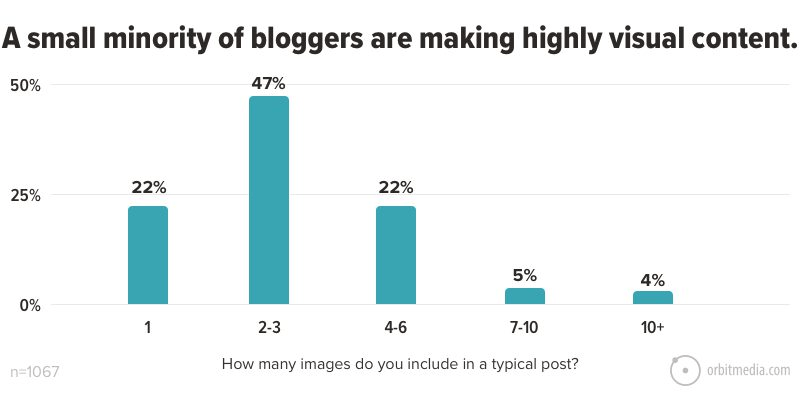
“On the average, five times as many people read the headline as read the body copy. When you have written your headline, you have spent eighty cents out of your dollar.” — David Ogilvy
- “Very long” headlines (14–17 words) outperform short headlines by 76.7% in terms of social sharing (Backlinko).
- Headlines with a question mark get 23.3% more social shares than non-question headlines (Backlinko).
- 91% of bloggers write only a few headline drafts (around six) before publishing (Orbit Media).
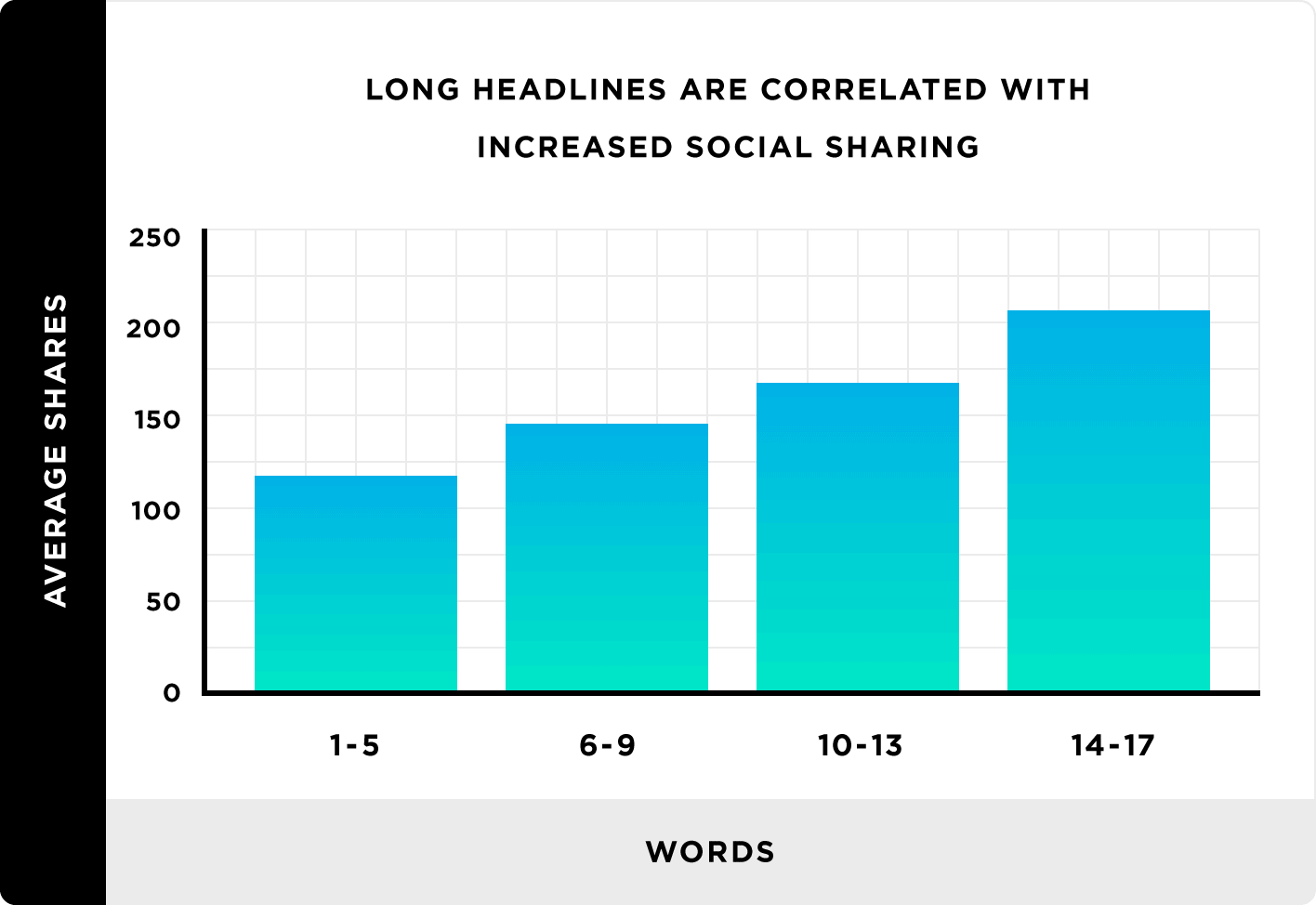
To get passive, consistent traffic to your blog, you should ensure the content ranks in the search engines.
- 68% of online experiences begin with a search engine (BrightEdge).
- 90.63% of pages get no organic search traffic from Google (Ahrefs).
- Only 5.7% of pages will rank in the top 10 search results within a year of publication (Ahrefs).
- The average page in the top 10 is 2+ years old (Ahrefs).
- The average top-ranking page also ranks in the top 10 search results for nearly 1,000 other relevant keywords (Ahrefs).
- Generally speaking, the more backlinks a page has, the more organic traffic it gets from Google (Ahrefs).
- There’s no correlation between Flesch Reading Ease scores and ranking positions (Ahrefs).
- 71% of bloggers say SEO is the most important source of traffic (Orbit Media).
- 85% of bloggers are doing keyword research (Orbit Media).
- Bloggers who earn over $50,000 per year tend to put a lot of emphasis on SEO. Their #1 traffic source is typically Google organic search; also, compared to lower-income bloggers, they are 4.3 times as likely to conduct keyword research (GrowthBadger).
- 71% of bloggers are updating old content (Orbit Media).
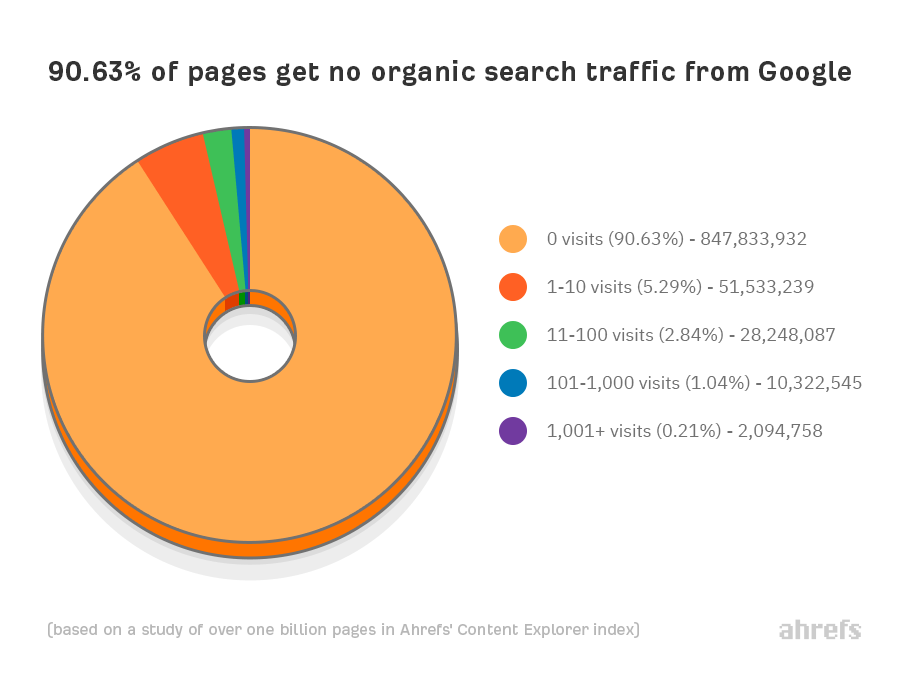
Your blog can’t go “viral” overnight. It needs to be discovered, promoted, and marketed.
- Only one-third of bloggers regularly check their blogs’ traffic analytics (Statista).
- Social media is the most popular channel for driving blog traffic (Orbit Media).
- 70% of bloggers who earn over $50,000 per year say they are active or very active promoters of their blogs compared to only 14% of lower-income bloggers (GrowthBadger).
- Bloggers who collaborate with influencers get better results (Orbit Media).
- Bloggers who earn over $50,000 per year from their blogs are over twice as likely to focus on getting email subscribers as compared to lower-income bloggers. They also use 343% as many email-collection methods as lower-income bloggers (GrowthBadger).
- 97% of bloggers promote their blog posts via social media, and 66% use email marketing to direct people toward their content (Statista).
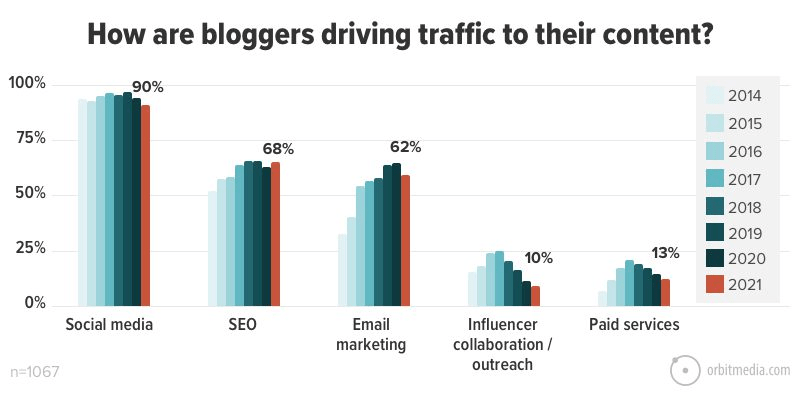
Social media is apparently the most popular channel for driving blog traffic. How can you optimize for this channel?
- 1.3% of articles get 75% of the social shares (Backlinko).
- The ideal content length for maximizing social shares is 1,000–2,000 words (Backlinko).
- There’s no “best day” to publish a new piece of content. Social shares are distributed evenly among posts published on different days of the week (Backlinko).

Guest blogging statistics
Guest blogging is alive and well, and it’s still a great way to acquire links and be exposed to a large audience.
- The average cost of publishing a paid guest post is $77.80 (Ahrefs).
- 50% of bloggers perform outreach for guest posts to 10 or fewer contacts a month, while 7% of them pitch to 100 or more blogs per month (ReferralRock).
- 60% of bloggers write one to five guest posts per month (ReferralRock).
- 87% of bloggers come up with guest post ideas themselves, but only 52% of them do the actual writing (ReferralRock).
- 93% of editors plan to publish the same amount of guest content or more (Influence & Co.).

Final thoughts
Want to learn more about blogging and content marketing? Get started with these guides:
Do you have other interesting statistics to share? Let me know on Twitter.

